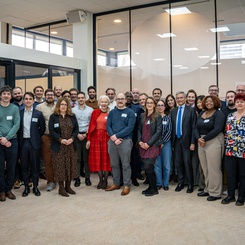With ESSEC Knowledge Editor-in-chief
With the recent success of COVID-19 vaccine development still in the forefront of our minds, how researchers and academics work with industry partners, like Oxford University with AstraZeneca, is more pertinent than ever. As the speed and success of the vaccine development shows, this kind of university-industry partnership can be fruitful not only for the partners themselves, but also for the broader community. One might assume that such partners need to have aligned goals, but there is little research exploring the impact of asymmetrical perceptions. A new study from Vivianna Fang He (ESSEC Business School), Georg von Krogh (ETH Zurich), Charlotta Sirén (University of St. Gallen) and Thomas Gersdorf (McKinsey & Company) unpacks the dynamics of collaboration project teams, building our understanding of how each side’s perspectives interact and influence the relationship and success.
Teamwork makes the dream work?
Collaborations like the one between Oxford and AstraZeneca are popular practices rather than exceptions in the pharmaceutical industry. Such collaborations can be mutually beneficial when it comes to creating and disseminating knowledge and transforming research into practical uses. That being said, there are many potential risks, such as opportunity costs and intellectual property concerns. Further, partners may go into the collaboration with divergent goals, and with different organizational cultures at play: firms are looking to make a profit on marketable goods and services, which may concern a very specific need at the present. In contrast, universities are aiming to produce scientific knowledge, which tends to be more general and long-term.
Much of the existing research assumes that this goal asymmetry, i.e. having these different goals and expectations, hinders collaboration- but this assumption does not have data backing it up. Many studies looked at only one side of the relationship, making it impossible to actually assess the impact of asymmetry, because we can’t compare the perspectives of each side. In their study, Dr. He and her colleagues examined the perspectives of both sides to get a better understanding of the true nature and impact of goal asymmetry.
Digging deeper
To uncover how goal asymmetry impacts university-industry collaborations, the researchers studied collaborations between a Big Pharma company and its academic partners (universities and university-affiliated teaching hospitals), located on three research sites in the US, Switzerland, and Singapore. Project teams are typically composed of a representative from the Big Pharma company and a principal investigator (usually a professor or postdoctoral researcher) from the academic institution, who share responsibility for the project, as well as team members from both sides.
They started by interviewing research scientists and senior managers who had been involved in such collaborations on both sides, then proceeded to administer two large-scale surveys to participants on both sides. The senior managers at the Big Pharma company were also asked to assess the projects’ success. Taken together, their study provided both qualitative and quantitative data, and allowed the researchers to compare and contrast the perspectives of both sides of the partnership.
Dr. He and her colleagues found evidence of asymmetry both in the goals and perceptions of team conflict between collaboration partners. For example, academics were more likely to prioritize publishing in scientific journals, whereas this was more of a bonus for the industry partners in some cases and in others even contentious as they may have other goals in mind for the knowledge, such as a patent, leading to different strategies for disclosing their findings. The researchers also found that both sides did recognize this asymmetry and didn’t necessarily see it as an issue. To quote one of the Big Pharma executives:
“The most successful collaboration I was ever in came from this project when the two sides (scientists from DrugCo and academics) had completely different goals. They(academics) just wanted to publish so did not care about IP and we only cared about bringing a drug to the market. We designed the project in a way that they could publish anything as long as it did not harm our IP. In the end, they published a lot of exciting things and we own 100% of the drug. It’s like one takes all the cream and the other gets the rest of the cake. No need for any cutting…”
However, as another manager pointed out, it is important to manage rather than ignore this asymmetry:
“In academia and in industry, goals are really quite different, right? We (scientists at DrugCo) are trying to develop drugs while they (academic partners) are trying to publish and get jobs. Sometimes that creates a bit of tension, but that’s just something to manage in these collaborations.”
They also identified two types of success valued by both sides, programmatic and relational. Programmatic success means the team accomplished what they set out to do, whereas relational success means that the interpersonal side went well and the team wants to continue the relationship.
While it’s true that conflict did impact success, it is not true that any conflict would impact all types of success. Conflict is not created equal. Cognitive conflict is when people disagree on task-related decisions or strategies or deployment of resources: it’s less personal, more about how to get the job done. Affective conflict, on the other hand, is very much personal, and looks more like personality clashes stemming from differences in norms and values. Not everyone perceives the same level of conflict, so it’s possible that different team members experienced the conflict in different ways, leading to another source of asymmetry.
The researchers found that in teams with goal asymmetry, there were higher rates of both types of conflict. In turn, both cognitive and affective conflict did have a negative impact on relational success. Put differently, conflict puts collaboration relationships under a “stress-test.”However, only affective conflict impacted programmatic success under the condition that the team displayed high perception asymmetry. This provides two critical lessons: first, not all types of conflict hindered the productivity of the team; second, even the most harmful type of conflict could be managed when the two partners have a consensus of the conflict at hand.
It takes two: implications for academia-industry collaboration
As we’ve seen over the last eighteen months, academia-industry collaborations prove to have important implications for society at large. They also offer value for the academic partners and the industry partners, although each side may be looking to get something different out of it: the academic partner tends to prioritize knowledge creation, novel science, and publications, whereas the industry side prioritizes the access to resources and producing marketable results. Furthermore, academics and practitioners can perceive team dynamics in a drastically different manner, making it important to consider others’ perspectives. Despite what you may assume, these asymmetries aren’t disastrous news unconditionally: the present study’s findings showed that asymmetry doesn’t have a direct negative effect on collaboration success, though it is associated with increased cognitive and affective conflict. Yet conflict itself isn’t the worst thing that can happen to a team: when managed properly, cognitive conflict could be a source of learning; even affective conflict only impacts the team’s programmatic success contingent on the presence of perception asymmetry. In other words, conflict dynamics do influence different collaboration outcomes under specific circumstances, making it essential to implement conflict management strategies and acknowledge the problem.
Tips for managing academia-industry relationships
Academia-industry collaborations are important but delicate, especially newly initiated ones. Some research-based tips for managers and organizations on anticipating and managing conflict include:
-
Closely and continuously monitoring conflict levels in the team
-
Implementing conflict management training
-
Be aware of the costs and benefits of different types of conflict, and be able to distinguish them
-
Following up on that, managers should have different solutions for different types of conflict: solutions for managing cognitive conflict include knowledge exchange workshops and discussion of problem-solving approaches, and solutions for affective conflict include team building activities and coaching sessions.
-
If possible, try to reduce perception asymmetry, which can worsen the impact of affective conflict on collaboration success
-
On the organizational side, offer tools on how to evaluate and manage intellectual property to manage expectations (this could be done, for instance, by the university itself or a funding agency)
Taken together, this study shows us that different goals and experiencing team conflict aren’t a death toll for successful academia-industry collaborations, but that it is important to acknowledge these differences and manage interpersonal conflict issues to avoid a detrimental impact on the success of the collaboration.
Reference
He, V. F., von Krogh, G., Sirén, C., & Gersdorf, T. (2021). Asymmetries between partners and the success of university-industry research collaborations. Research Policy, 50(10), 104356.









